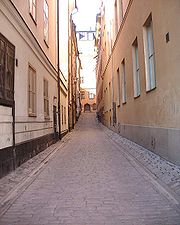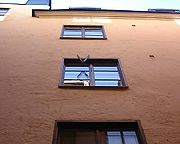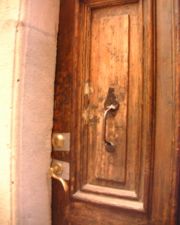
Telegrafgränd
Encyclopedia




Alley
An alley or alleyway is a narrow lane found in urban areas, often for pedestrians only, which usually runs between or behind buildings. In older cities and towns in Europe, alleys are often what is left of a medieval street network, or a right of way or ancient footpath in an urban setting...
in Gamla stan
Gamla stan
Gamla stan , until 1980 officially Staden mellan broarna , is the old town of Stockholm, Sweden. Gamla stan consists primarily of the island Stadsholmen. The surrounding islets Riddarholmen, Helgeandsholmen, and Strömsborg are officially part of, but not colloquially included in, Gamla stan...
, the old town of Stockholm
Stockholm
Stockholm is the capital and the largest city of Sweden and constitutes the most populated urban area in Scandinavia. Stockholm is the most populous city in Sweden, with a population of 851,155 in the municipality , 1.37 million in the urban area , and around 2.1 million in the metropolitan area...
, Sweden
Sweden
Sweden , officially the Kingdom of Sweden , is a Nordic country on the Scandinavian Peninsula in Northern Europe. Sweden borders with Norway and Finland and is connected to Denmark by a bridge-tunnel across the Öresund....
. Stretching from Skeppsbron
Skeppsbron
Skeppsbron is both a street and a quay in Gamla stan, the old town of Stockholm, capital of Sweden, stretching from the bridge Strömbron in front of the Royal Palace southward to Slussen....
to Österlånggatan
Österlånggatan
Österlånggatan is a street in Gamla stan, the old town of Stockholm, Sweden. Stretching southward from Slottsbacken to Järntorget, it forms a parallel street to Baggensgatan and Skeppsbron...
, it is a parallel street to Slottsbacken
Slottsbacken
Slottsbacken is a street in Gamla stan, the old town in central Stockholm, Sweden.It stretches east from the Stockholm Cathedral and the Royal Palace down to the street Skeppsbron which passes along the eastern waterfront of the old town...
and Skeppar Karls Gränd
Skeppar Karls Gränd
Skeppar Karls Gränd is an alley in Gamla stan, the old town of Stockholm, Sweden. Stretching from Skeppsbron to Österlånggatan, it forms a parallel street to Telegrafgränd and Bredgränd....
.
Origin of the name
The alley is named after the telegraph inaugurated in 1869 and located in the block north of the alley. Formerly it was named Saltkompanigränden ("The Salt Company Alley") after the saltSalt
In chemistry, salts are ionic compounds that result from the neutralization reaction of an acid and a base. They are composed of cations and anions so that the product is electrically neutral...
manufacturer from Västervik
Västervik
Västervik is a city and the seat of Västervik Municipality, Kalmar County, Sweden with 20,694 inhabitants in 2005.- History :Västervik was first mentioned in 1275. The town was then located at the current location of Gamleby. In 1433 Eric of Pomerania decided to give it a charter and move it to its...
who had a warehouse built on a site they bought in 1647. In 1508, the alley was called Lindhwidz grend, presumably after a skipper known as Lindivd skeppare, in 1512 fined for having brought 100 loads of "mould and muck from the gate to the bridge" (e.g. into town).
In 1875, several companies operating in the neighbourhood urged the name to be changed to the present name, arguing the old name was circumstantial and often confused with other local names (Saltmätaregränden ("The salt Measurer's Alley"), today Gåsgränd
Gåsgränd
Gåsgränd is an alley in Gamla stan, the old town in central Stockholm, Sweden. Connecting the streets Västerlånggatan, Stora Nygatan, and Lilla Nygatan, it forms a parallel street to Ignatiigränd and Överskärargränd, and leads down to the square Munkbron on the western waterfront of the old town...
, and Saltmätaregatan, in today's Vasastaden
Vasastaden, Stockholm
Vasastaden, or colloquially Vasastan, is a 3.00 km² large city district in central Stockholm, Sweden. With 51,661 inhabitants it is the second most populous, as well as the second most densely populated district in Stockholm.The major parks in Vasastaden are Vasaparken and Observatorielunden...
), and the City Council had no objections. A proposal from Gamla stan's folk society in 1953 to resume the old name proved unsuccessful.
A walk east to west
The present building on Number 2 (Aeolus 1) was constructed for the national telegraph department (Telegrafverket) in 1868-70 to the design of architect Ludvig Hawerman followed by various devastating reconstructions before the restoration of Ivar TengbomIvar Tengbom
Ivar Justus Tengbom was a Swedish architect and one of the best-known representatives of the Swedish neo-classical architecture of the 1910s and 1920s....
in 1951-59. During the Middle Ages, this was the location of the northernmost defensive tower in the eastern city wall
Defensive wall
A defensive wall is a fortification used to protect a city or settlement from potential aggressors. In ancient to modern times, they were used to enclose settlements...
built during the 14th and 15th centuries. As a result of a reconstruction in the mid 18th century, the lot of the salt company building facing Slottsbacken was united with the one facing Telegrafgränd and in 1782 the building was completely reconstructed again. It was the location for the National Archives (Riksarkivet
Riksarkivet
Riksarkivet is one of the oldest public agencies in Sweden, with a history leading back to the Middle Ages. The chief of Riksarkivet is called the Riksarkivarie....
) and the Royal Academy of Letters, History and Antiquities
Royal Swedish Academy of Letters, History and Antiquities
The Royal Swedish Academy of Letters, History and Antiquities also called simply the Royal Academy of Letters, abbreviated KVHAA is the Swedish royal academy for the Humanities.Its many publications include the archaeological and art historical journal Fornvännen, published since 1906.The Academy...
(Kungliga Vitterhets-, Historie- och Antikvitetsakademien (KVHAA) or Vitterhetsakademien for short) during the period 1848-1863.
In medieval times, the building along the south-eastern part of the alley (Bootes 5 facing Skeppsbron) was separated from the southern part of the block by a narrow alley, the western end of which is still discernible on 3-5, Österlånggatan. The eastern end of the alley was bought by Secretary Israel Isrealsson Lagerfelt (1610-1684) who built the present building on the lot.
The building on Number 4-6 (Aeolus 3) was designed by Ingvar Tengbom 1952-1954. On the lot the councillor Erik Fleming
Erik Fleming
Erik Robert Fleming was a member of the Mississippi House of Representatives representing the 72nd District from 1999 to 2008. He was the Democratic nominee for one of the state's two U.S. Senate seats...
had a three-storey building constructed in the 1660s. On its demolition the original decorated wainscots discovered were safeguarded by the Stockholm City Museum
Stockholm City Museum
The Stockholm City Museum is a museum documenting and exhibiting the history of Stockholm. The museum is housed in Södra Stadshuset at Slussen on Södermalm. The building was completed in 1685...
.
The basement of Number 1 (Bootes 4) is possibly preserved from the Middle Ages, while the Y-shaped wall anchors between the first and second floors are considerably younger, the third floor is from the first half of the 17th century, and the top floor if from 1652. The building was extensively rebuilt in 1875 and 1902 which gave the façade most of its present appearance.
The building on Number 3 (Bootes 3), rebuilt in the 17th century, was united with the building on the opposite side of the alley during the 18th and 19th centuries. It was rebuilt in 1907, from when it got most of its present appearance, while it conceals remains of medieval walls shared with Number 5.
While both the interior and the exterior of Number 5 (Bootes 2) mostly dates back to a reconstruction in 1764, the extent of the building is a century older, and the walls of first three storeys are preserved from the Middle Ages (the fork-shaped wall anchors and the decorated doors are from the 17th century though).
External links
- Stockholmskällan - Historical photo of a portico in the alley
- http://www.hitta.se/SearchCombi.aspx?__VIEWSTATE=%2FwEPDwUKMTg4NDI3NTMzNWRk&UCSB%3AWflWhite=1a1b&UCSB%3AWflPink=4a&SearchType=4&UCSB%3ABBX1=&UCSB%3ABBY1=&UCSB%3ABBX2=&UCSB%3ABBY2=&UCSB%3ATextBoxWho=&UCSB%3ATextBoxWhere=Telegrafgr%E4nd+Stockholm&UCSB%3AButtonSearch=%A0%A0hitta%21%A0%A0&CombiDetails%3AMapControl%3Acx=1629138&CombiDetails%3AMapControl%3Acy=6580541&CombiDetails%3AMapControl%3ApointsHidden=&CombiDetails%3AMapControl%3Az=3hitta.se - Location map and virtual walk]

